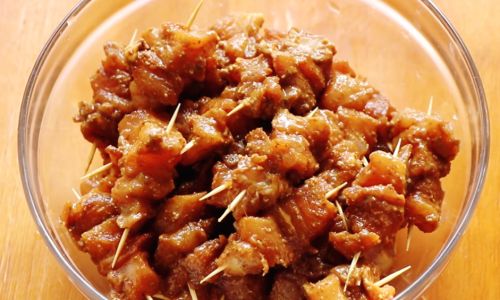Introduction
In the realm of culinary delights, toothpick meat, or “toothpick-skewered meat,” stands as a testament to the harmony between simplicity and sophistication. This dish, often associated with street food cultures across Asia and beyond, encapsulates the essence of flavorful, tender meat that’s been meticulously prepared to achieve the perfect balance of crispiness, aroma, and taste. Whether you’re a seasoned chef or an enthusiastic home cook, mastering the art of crafting toothpick meat that is both visually appealing and mouthwateringly delicious requires a blend of precision, patience, and a keen understanding of ingredient selection and cooking techniques. This comprehensive guide aims to demystify the process, ensuring that you can create toothpick meat that is not just satisfying but also a culinary masterpiece.
Section 1: Understanding the Basics

Before diving into the specifics of how to make toothpick meat crispy, aromatic, and delicious, it’s crucial to grasp the foundational elements that contribute to its success. Toothpick meat typically consists of small pieces of meat, often pork, chicken, or beef, that have been marinated, skewered on toothpicks, and then grilled or fried until golden brown and perfectly cooked.
1 Ingredient Selection
- Meat Quality: Opt for high-quality, lean meat with a good fat-to-lean ratio. This ensures that the meat remains juicy and flavorful during cooking. Pork belly, chicken thighs, and beef sirloin are excellent choices.
- Marinades: The marinade is key to infusing the meat with flavor. A blend of soy sauce, garlic, ginger, honey, sesame oil, and a touch of rice vinegar or lemon juice can create a harmonious balance of savory, sweet, and tangy notes.
- Toothpicks: Ensure you use wooden or bamboo toothpicks that have been soaked in water for at least 30 minutes to prevent them from burning during cooking.
2 Preparation Techniques
- Cutting the Meat: Cut the meat into small, uniform cubes or strips. This ensures even cooking and makes it easier to handle and eat.
- Marinating: Marinate the meat for at least 2 hours, preferably overnight, to allow the flavors to deeply penetrate the meat.
- Skewering: Thread the marinated meat onto the soaked toothpicks, ensuring they are not overcrowded. This allows for even heat distribution during cooking.
Section 2: Achieving Crispiness

Crispiness in toothpick meat is a delicate balance of cooking method, temperature control, and ingredient interaction. Here’s how to nail it:
1 Cooking Methods
- Grilling: Grilling over an open flame or charcoal grill adds a smoky aroma and a beautiful caramelized crust to the meat. Use medium-high heat and turn the toothpicks frequently to avoid burning.
- Frying: Deep-frying or pan-frying in hot oil (around 350°F or 175°C) creates an instant crispiness. Ensure the oil is hot enough to seal in the juices and form a crispy exterior.
- Air Frying: For a healthier option, an air fryer can be used. It mimics the texture of fried food with minimal oil, providing a crispy result without the guilt.
2 Temperature and Timing
- Grilling: Aim for an internal temperature of 145°F (63°C) for pork and chicken, and 135°F (57°C) for beef (medium-rare). Cook until the exterior is golden brown and slightly charred.
- Frying: Monitor the oil temperature closely and cook in batches to maintain the oil’s temperature. Fry for about 2-3 minutes, or until golden brown.
- Air Frying: Preheat the air fryer to 375°F (190°C) and cook for about 8-10 minutes, shaking the basket halfway through to ensure even cooking.
3 Finishing Touches

- Coating: A light dusting of cornstarch or potato starch before frying can help create an extra-crispy exterior.
- Resting: After cooking, let the toothpick meat rest for a few minutes. This allows the juices to redistribute, ensuring a juicy interior without losing the crispy exterior.
Section 3: Enhancing Aroma and Flavor
The aroma and flavor of toothpick meat are what truly elevate it from an ordinary snack to a culinary delight. Here are some strategies to maximize these sensory experiences:
1 Aromatics and Spices
- Fresh Herbs and Spices: Incorporate fresh garlic, ginger, and green onions into the marinade. For an extra layer of flavor, consider adding spices like five-spice powder, cumin, or paprika.
- Citrus Elements: A squeeze of fresh lemon or lime juice before serving brightens up the flavors and adds a refreshing tang.
- Toasted Sesame Seeds: Sprinkle toasted sesame seeds over the cooked toothpick meat for a nutty aroma and crunch.
2 Sauce and Garnishes

- Dipping Sauces: Serve with a variety of dipping sauces such as soy sauce mixed with chili oil, sweet and sour sauce, or a garlic-ginger sauce. These sauces enhance the meat’s flavor and provide a contrast in texture and taste.
- Garnishes: Add chopped scallions, cilantro, or sesame leaves for a burst of color and freshness.
3 Cooking Techniques for Aroma
- Searing: Before grilling or frying, sear the meat on all sides in a hot pan to lock in juices and develop a rich, caramelized crust that releases aromatic compounds.
- Smoking: If using a charcoal grill, add wood chips or herbs like applewood or rosemary to the coals for an additional layer of smoke flavor.
Section 4: Presentation and Serving
Presentation is half the battle won when it comes to toothpick meat. Here’s how to make your dish visually appealing and inviting:
1 Arrangement

- Platter Selection: Use a clean, white platter to make the golden-brown toothpick meat stand out.
- Neatness: Arrange the toothpicks in a neat, overlapping pattern or create a circular pattern for a visually pleasing presentation.
2 Garnishes and Accompaniments
- Edible Garnishes: Use edible flowers, microgreens, or thin slices of radish for a touch of elegance.
- Accompaniments: Serve with a side of pickled vegetables, steamed rice, or a fresh salad to balance the rich flavors of the meat.
Conclusion
Crafting toothpick meat that is crispy, aromatic, and delicious is an art form that combines culinary precision with creative flair. By carefully selecting ingredients, mastering cooking techniques, and paying attention to detail in presentation, you can transform this humble street food into a gourmet delight. Remember, the key to success lies in balance – not overcooking the meat, using a variety of flavors to create depth, and ensuring the dish is visually appealing. With practice and patience, you’ll soon be serving toothpick meat that is the envy of all who taste it, making every bite a journey through flavors and textures that linger long after the meal is over. Happy cooking!





0 comments